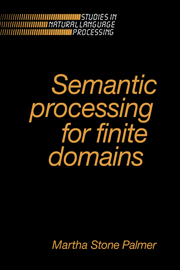1 - Problems in the semantic analysis of text
Published online by Cambridge University Press: 24 November 2009
Summary
Introduction
A primary problem in the area of natural language processing is the problem of semantic analysis. This involves both formalizing the general and domain-dependent semantic information relevant to the task involved, and developing a uniform method for access to that information. Natural language interfaces are generally also required to have access to the syntactic analysis of a sentence as well as knowledge of the prior discourse to produce a detailed semantic representation adequate for the task.
Previous approaches to semantic analysis, specifically those which can be described as using templates, use several levels of representation to go from the syntactic parse level to the desired semantic representation. The different levels are largely motivated by the need to preserve context-sensitive constraints on the mappings of syntactic constituents to verb arguments. An alternative to the template approach, inference-driven mapping, is presented here, which goes directly from the syntactic parse to a detailed semantic representation without requiring the same intermediate levels of representation. This is accomplished by defining a grammar for the set of mappings represented by the templates. The grammar rules can be applied to generate, for a given syntactic parse, just that set of mappings that corresponds to the template for the parse. This avoids the necessity of having to represent all possible templates explicitly. The context-sensitive constraints on mappings to verb arguments that templates preserved are now preserved by filters on the application of the grammar rules.
- Type
- Chapter
- Information
- Semantic Processing for Finite Domains , pp. 1 - 29Publisher: Cambridge University PressPrint publication year: 1990



